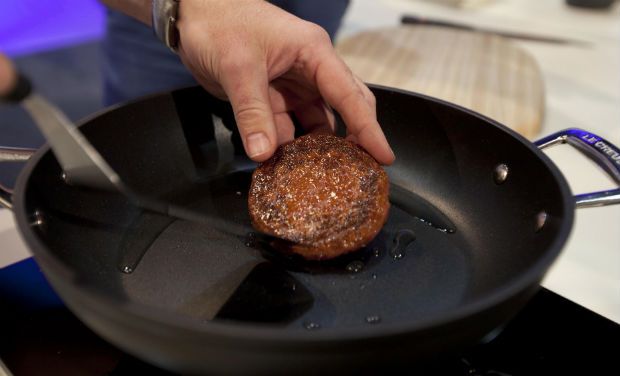A new Cultured Beef Burger made from cultured beef grown in a laboratory from stem cells of cattle, is cooked by chef Richard McGeown during the world’s first public tasting event for the food product held in London on Aug 5. AP photo
London: The food of the future could do with a pinch of seasoning – and may be some cheese.
Two volunteers who took the first public bites of a hamburger grown in a laboratory gave it good marks for texture but agreed there was something missing.
“I miss the salt and pepper,” said Austrian nutritionist Hanni Ruetzler, adding that the patty was “close to meat” but “not that juicy.” US journalist Josh Schonwald confessed to a difficulty in judging a burger “without ketchup, onions, jalapenos or bacon.” Both tasters shunned the bun, lettuce and sliced tomatoes offered to them to concentrate on the flavour of the meat itself.
Dr Mark Post, the Dutch scientist who led the team that grew the meat from cattle stem cells, regretted having served the patty without his favourite topping: aged gouda cheese.
“That would have enhanced the whole experience,” he said. He, however, added that he was pleased with the reviews.
Dr Post, whose team at Maastricht University in the Netherlands developed the burger over five years, hopes that making meat in labs could eventually help feed the world and fight climate change – although that goal is probably a decade or two away, at best.
“The first (lab-made) meat products are going to be exclusive,” said Isha Datar, director of New Harvest, an international nonprofit that promotes meat alternatives. “These burgers won’t be in Happy Meals before someone rich and famous is eating them.”
Sergey Brin, a co-founder of Google, announced that he funded the 2,50,000-euro project, saying he was motivated by a concern for animal welfare. Animal rights group PETA has also supported the initiative.
How the lab burger was created
1. Professor Mark Post of Maastricht University started with stem cells extracted from cow muscle tissue. In the laboratory, these are cultured with nutrients and growth promoting chemicals to help them develop and multiply.
2. Three weeks later, there are more than a million stem cells which are put into smaller dishes where they coalesce into small strips of muscle about a centimetre long and a few millimetres thick.
3. These strips are collected into small pellets which are frozen. When there are enough, they are defrosted and compacted into a patty just before being cooked.
4. Helen Breewood, who is working with Prof Post, makes the lab-grown muscle look red by adding the naturally occurring compound myoglobin.
5. On August 5, the world’s first lab-grown beef burger, costing a whopping £2,15,000 was cooked up and tasted in public. Earlier, Prof. Post had said that initial sampling suggests the burger will not taste great, but he expected it to be “good enough”
Lab Burger FAQs
Q: Why is the meat so expensive to produce?
A: The technology is new and scientists are making very small quantities of meat. There are no economies of scale to offset the initial high costs. If more scientists or companies start using the technology to produce more meat products, that could drop the price substantially.
Q: When will this meat be in stores?
A: Probably not for another 10 to 20 years. It would take years to refine the technology, encourage other producers and scientists to get involved, and overcome any regulatory issues.
Q: How long does it take to grow a burger?
A: At the moment, a long time. It has taken two years for scientists to grow enough meat for two hamburgers. The research into the process started in 2006. Once there are enough strands of meat (about 20,000 small strands), scientists can form a five-ounce (140-gram) hamburger patty in about two hours.
Q: What are the implications for vegetarians?
A: PETA, People for the Ethical Treatment of Animals, supports attempts to grow meat in labs because they say that will greatly diminish the amount of animal suffering. Donor animals are needed for the muscle cells, but taking those samples doesn’t hurt the animal.
One sample can provide theoretically, up to 20,000 tons of lab-made meat. But lab-grown meat is still meat, and not an option for vegetarians.
Q: Is it possible to make other kinds of meat in the laboratory?
A:Yes. The science is theoretically the same, so the same techniques should also allow researchers to make chicken, fish, lamb, etc. Dutch researcher Mark Post, who led the research on the lab-made ham, started working with pig cells.

